Feline dental radiography and radiology: A primer
- PMID: 25344459
- PMCID: PMC11044607
- DOI: 10.1177/1098612X14552366
Feline dental radiography and radiology: A primer
Abstract
Practical relevance: Information crucial to the diagnosis and treatment of feline oral diseases can be ascertained using dental radiography and the inclusion of this technology has been shown to be the best way to improve a dental practice. Becoming familar with the techniques required for dental radiology and radiography can, therefore, be greatly beneficial.
Clinical challenges: Novices to dental radiography may need some time to adjust and become comfortable with the techniques. If using dental radiographic film, the generally recommended 'E' or 'F' speeds may be frustrating at first, due to their more specific exposure and image development requirements. Although interpreting dental radiographs is similar to interpreting a standard bony radiograph, there are pathologic states that are unique to the oral cavity and several normal anatomic structures that may mimic pathologic changes. Determining which teeth have been imaged also requires a firm knowledge of oral anatomy as well as the architecture of dental films/digital systems.
Evidence base: This article draws on a range of dental radiography and radiology resources, and the benefit of the author's own experience, to review the basics of taking and interpreting intraoral dental radiographs. A simplified method for positioning the tubehead is explained and classic examples of some common oral pathologies are provided.
© ISFM and AAFP 2014.
Conflict of interest statement
The author declares that there is no conflict of interest.
Figures
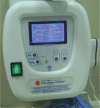






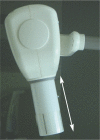









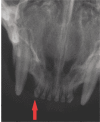

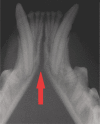
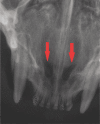







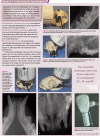
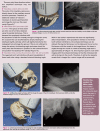

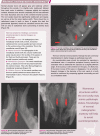




Similar articles
-
Radiographic signs and diagnosis of dental disease.Semin Vet Med Surg Small Anim. 1993 Aug;8(3):138-45. Semin Vet Med Surg Small Anim. 1993. PMID: 8210796 Review.
-
Dental Radiography and Radiographic Signs of Equine Dental Disease.Vet Clin North Am Equine Pract. 2020 Dec;36(3):445-476. doi: 10.1016/j.cveq.2020.08.001. Epub 2020 Oct 14. Vet Clin North Am Equine Pract. 2020. PMID: 33067094 Review.
-
Oral-dental radiographic examination technique.Vet Clin North Am Small Anim Pract. 1998 Sep;28(5):1063-87, v. doi: 10.1016/s0195-5616(98)50103-9. Vet Clin North Am Small Anim Pract. 1998. PMID: 9779541 Review.
-
A Standard Method for Intraoral Dental Radiography With Dental Photo-Stimulative Phosphor (PSP) Plates in Big Cats.J Vet Dent. 2022 Dec;39(4):337-345. doi: 10.1177/08987564221126373. Epub 2022 Sep 25. J Vet Dent. 2022. PMID: 36154331
-
A rapid screening technique for feline odontoclastic resorptive lesions.J Small Anim Pract. 2004 Dec;45(12):598-601. doi: 10.1111/j.1748-5827.2004.tb00181.x. J Small Anim Pract. 2004. PMID: 15600270
Cited by
-
Recasting the gold standard - part I of II: delineating healthcare options across a continuum of care.J Feline Med Surg. 2023 Dec;25(12):1098612X231209855. doi: 10.1177/1098612X231209855. J Feline Med Surg. 2023. PMID: 38131211 Free PMC article. Review.
-
Intra-socket application of medical-grade honey after tooth extraction attenuates inflammation and promotes healing in cats.J Feline Med Surg. 2022 Dec;24(12):e618-e627. doi: 10.1177/1098612X221125772. Epub 2022 Oct 31. J Feline Med Surg. 2022. PMID: 36315457 Free PMC article.
-
Tooth resorption in cats: pathophysiology and treatment options.J Feline Med Surg. 2015 Jan;17(1):37-43. doi: 10.1177/1098612X14560098. J Feline Med Surg. 2015. PMID: 25527492 Free PMC article. Review.
-
Mandibular fracture repair techniques in cats: a dentist's perspective.J Feline Med Surg. 2023 Feb;25(2):1098612X231152521. doi: 10.1177/1098612X231152521. J Feline Med Surg. 2023. PMID: 36744847 Free PMC article. Review.
-
The Cat Mandible (II): Manipulation of the Jaw, with a New Prosthesis Proposal, to Avoid Iatrogenic Complications.Animals (Basel). 2021 Mar 4;11(3):683. doi: 10.3390/ani11030683. Animals (Basel). 2021. PMID: 33806397 Free PMC article. Review.
References
-
- Niemiec BA. Case based dental radiology. Top Companion Anim Med 2009; 24: 4–19. - PubMed
-
- Woodward TM. Dental radiology. Top Companion Anim Med 2009; 24: 20–36. - PubMed
-
- Niemiec BA, Sabitino d, Gilbert T. Equipment and basic geometry of dental radiography. J Vet Dent 2004; 21: 48–52. - PubMed
-
- Mulligan TW, Aller MS, Williams CA. Atlas of canine and feline dental radiology. Trenton: Veterinary Learning Systems, 1998.
-
- Niemiec BA. Digital dental radiography. J Vet Dent 2007; 24: 192–197. - PubMed
Publication types
MeSH terms
LinkOut - more resources
Full Text Sources
Other Literature Sources

